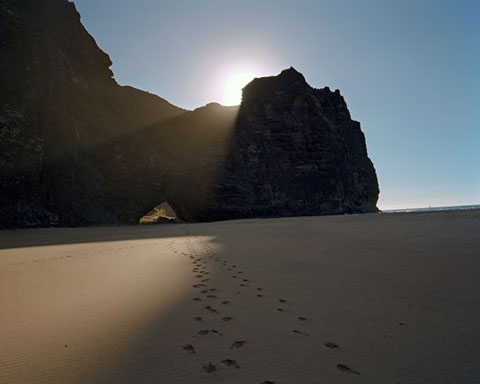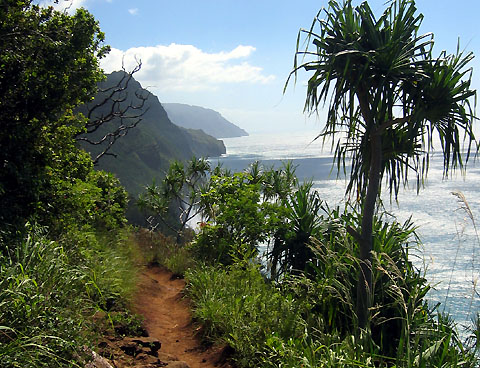by Joel K. Bourne, Jr. in the April 2008 issue of National Geographic
Along Hawaii's Na¯ Pali cliffs, an earthly paradise is under siege. The road to Shangri-la is supposed to be an ephemeral thing, a mystical path to a hidden valley where peace and beauty prevail. But on the Hawaiian island of Kaua'i it's simply Kuhio Highway, a twisty two-lane blacktop that ends in a muddy parking lot on the island's north shore. There, past the sands of Ke¯'e¯ Beach, the cliffs of Na¯ Pali rise straight from the green Pacific like
giant palisades that keep the modern world at bay.
It's a lovely illusion, of course. Unlike the fabled Shangri-la, Na¯ Pali is emblazoned on every tourist map of Kaua'i—and this magazine is partly to blame. A single photo in a 1960 article on Hawaii unveiled a lush valley shielded by 3,000-foot cliffs to a generation hungry for just such a place. The caption read: "Napali's towering cliffs wall a Shangri-la valley accessible only by sea.… Junglelike glens tucked amid the ridges offer an unspoiled
world for the adventurous."
That image, and many more that followed in print and film, inspired a pilgrimage that continues to this day. Some visitors kayak the 15-mile stretch of fluted cliffs, sea caves, and scalloped beaches during the calm seas of summer; others make the trip in "extreme" rafts, outboard-powered assault craft that can surmount almost any sea. Even more take the one-hour helicopter tour to get the Jurassic Park view—Na¯ Pali starred in that movie, as well
as in King Kong, South Pacific, and many other Hollywood fantasies. The young in heart and leg hike a harrowing 11-mile goat trail to the largest of the valleys, called Kalalau, where they often overstay their five-day camping permits by weeks or even months.
All are latecomers to a geologic drama that has played out over millions of years. The Na¯ Pali Coast is the scarred shoulder of an ancient shield volcano that once rose more than five miles from seafloor to summit. Like all the Hawaiian islands, Kaua'i was born over a plume of magma called a hot spot. As tectonic forces moved the island off the hot spot, its volcanic fires cooled and water, Earth's elemental sculptor, took over.
Rain—nearly a hundred inches a year in parts of Na¯ Pali—carved out the deep valleys from above and draped white-plumed waterfalls over the precipices. Giant winter waves exploded against the basalt cliffs as sea level rose and fell, gouging steep, unstable slopes. The result: a series of plunging valleys, fluted walls, and razor-sharp ridges soaring thousands of feet from the Pacific. On big screens
and small, Na¯ Pali has come to represent paradise on Earth.
For the early Hawaiians, it was also home, a place to fish and plant their terraced taro fields. Their presence is palpable in Nu'alolo Kai, one of the westernmost valleys along the coast, now accessible only by boat. Signs of more than six centuries of continuous occupation dot the landscape: stone walls, ceremonial platforms, remnants of houses and canoe shelters, as well as numerous burial sites.
In Hawaiian culture everything in the world contains mana, a spiritual power imbued by the gods and the ancestors. The mana at Nu'alolo Kai is so strong even a visitor from halfway across the globe gets goose bumps. "The Hawaiians call the feeling 'chicken skin,' " says Alan Carpenter, an archaeologist with Hawaii's division of state parks, which administers the area. "I get it every time I come here."
For Randy Wichman and Sabra Kauka, this valley also inspires a powerful sense of peace and serenity. The two native Hawaiians are members of Na¯ Pali Coast 'Ohana, a local nonprofit group formed to protect the cultural sites along the coast. "I have a board member who can't take Novocain," Kauka says. "So when he recently had a root canal, he just visualized himself here. I think his dentist was more nervous than he was."
Carpenter and Wichman take me to one of the platforms beneath the amphitheater of the cliff, and together we try to imagine the celebrations that occurred here centuries earlier. During 'awa ceremonies—'awa, or kava, being the favorite ritual drink of Polynesia—high priests performed ritual sacrifices, hula dancers swayed to the beat of drums, and from the highest cliff, called Kamaile, young men hurled burning javelins like comets into the sea. These fireworks
were so spectacular even King Kamehameha II made a special trip to view them.
Yet fireworks and celebrations were not enough to sustain these native Hawaiians. Perhaps they were cut down by Western diseases that ravaged the islands during the 1800s. Or maybe their traditional trading system no longer worked in the new money-based economy. No one knows for sure. But after more than 600 years of continuous habitation, the last permanent residents left the valley in the early 1900s for more populated parts of the island.
According to Carpenter, the parks archaeologist, Nu'alolo Kai is one of the more important archaeological sites on the islands. A decade of budget cuts, however, has created a maintenance backlog of 125 million dollars in the state's parks, making it tough to maintain even a picnic shelter and composting toilet at the site.
Care of the area falls largely to volunteers and local watermen, with Carpenter and other archaeologists providing expertise and sharing in the sweat. It's tough work, clearing brush, rebuilding stone structures, and hauling trash. But for Sabra Kauka, it provides a personal connection to the landscape, one she hopes isn't lost on the many local students she brings here to help with the work.
"In Hawaiian there is a saying, 'Ma ka hana ka 'ike—In the work is the knowledge,'" she says. "If you want to learn about this place, you have to take care of this place, and then it will reveal itself to you."
Her words echo in my ears a few days later as I slowly work my way across a crumbling pali (na¯ pali means "the cliffs" in Hawaiian) on the trail to the Kalalau Valley. Sweat falls in steady drops from my hat to the narrow trail, which wends a very fine line between a rock wall and a sheer 800-foot drop to the sparkling sea. Early Western visitors reported seeing Hawaiians running along these trails, sometimes two abreast. Today a parade of "flightseeing"
helicopters buzz by like giant gnats.
Despite the difficulty of the trail, I pass several people coming and going, some of the half million visitors from all over the world who flock here each year. The ones I meet include some serious hikers, a few college kids in bathing suits and sandals, and one or two obvious "Kalalau outlaws"—bearded men in their 40s or 50s with ragged clothes and furtive looks. These modern-day hermits live in the remote valley, eluding occasional roundups to evict
them.
With abundant water, rich soils, and plenty of papaya, coconut, and java plum trees, Kalalau has provided refuge for many outcasts over the years. In 1893 several Hawaiians with leprosy moved their families to the valley to keep from being banished to the dreaded leper colony on Moloka'i. When the deputy sheriff of Waimea came to round up the sick ones, a well-known cowboy and crack shot named Ko'olau refused to go without his wife and son. The standoff lasted into
the night, until shots rang out and the deputy fell dead. Hawaii's new provisional government, fresh from deposing Queen Lili'uokalani, feared an open revolt and sent the army after the cowboy. But Ko'olau evaded his pursuers in the cracks and crags of the valley, eventually dying there of his disease. "Ko'olau the Leper" became a modern folk hero of Hawaii.
Decades later another group of social outcasts sought peace in the valley—young hippies who spent years living off the land and communing with nature until eventually they were rousted out by the law. At a bend in the trail I meet one hiker of that generation and ask him if he'd been to Kalalau. "I was there in the 1960s," he said with a warm smile. "It was pristine. Everybody ran around naked. But hey, it was the '60s!"
When I finally reach the magical valley with its folded cliffs and sinuous beach, the vibe is more frat party than nudist retreat. Dozens of campers, some apparently long-term, are scattered among the trees behind the beach. A group of college kids have a boombox blaring, and a woman with bright red hair is shaving her legs in the valley's famous waterfall. Bags of garbage, old coolers, and discarded tents are strewed about the campsites and sea caves, waiting for work
crews to haul them out by helicopter—the greatest expense for the cash-strapped park.
"The challenge of managing Kalalau is its isolation, which is also its attraction," state parks administrator Dan Quinn told me later. "If we'd get more people carrying out what they carry in, it would be a better experience for everyone."
As I watch the sun melt into the sea, a passing shower uncorks a magnificent rainbow. How could humans trash such an earthly paradise? The fictional Shangri-la, as portrayed in James Hilton's 1933 novel Lost Horizon, was inspired by the Buddhist concept of Shambhala, a mythical place of peace and tranquillity reached by enlightened beings. Maybe we aren't there yet.
On my last day in Kalalau, however, I meet someone who seems well along the way. A young outlaw with a massive backpack bounds down the last stretch of trail as I'm starting the long climb out. He drops his burden at my feet, sprawls on the grass, and tells me his name is Eric. He's planning to stay for two months in a cave up the valley, foraging, meditating, and "getting centered" with the universe. "You go back up that valley and there are rock platforms,
taro fields, sacred altars all the way up," he says. "It was a metropolis in there! It's the land of the menehune, the ancient ones. It's primal!"
Eric is bright, articulate, and seems utterly at peace with himself and the world. We chat for a while, and then he picks up his 75-pound pack as if it were full of feathers and lopes down the trail, singing a joyful tune. "Enjoy your journey on planet Earth!" he shouts in parting. And for the rest of the day, I do.

image above: Photo by Diane Cook and Len Jenshel of Honopu Beach. The end of the trail.
|

